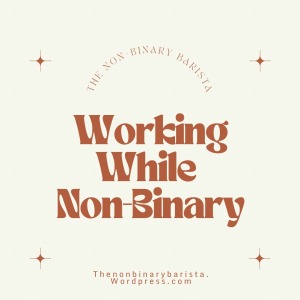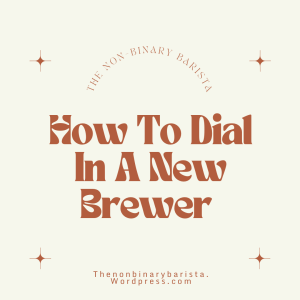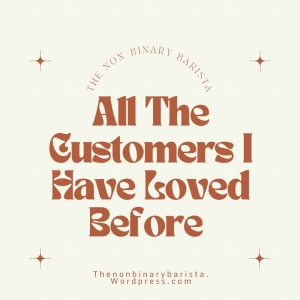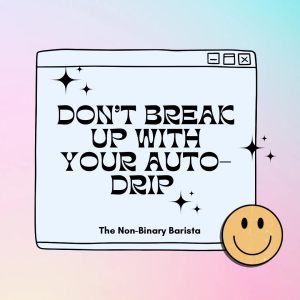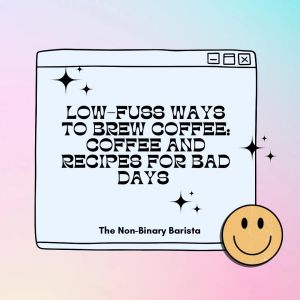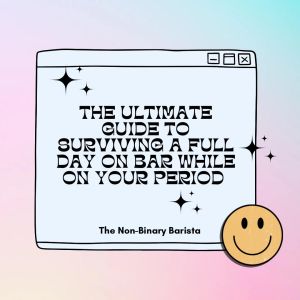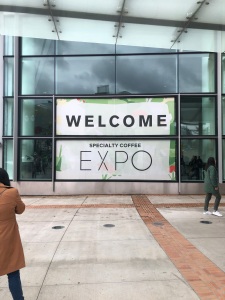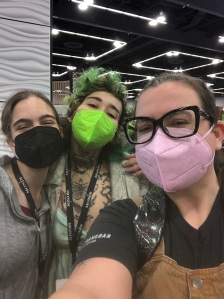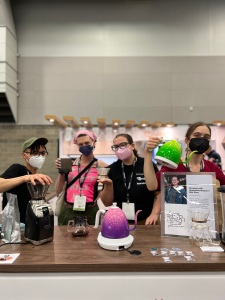When I started this blog, I was working at a cafe in Portland, Oregon where nearly all the staff was gender nonconforming and/or queer. It was a special place, not necessarily because everything was perfect (it was far from it) but because I felt truly seen. I started at this place as a temporary employee but, still, I was asked what my pronouns were, how comfortable I was with everyone knowing my pronouns/identity, and we all had this common queer understanding that is hard to put into words to non-queer people. We all just got each other on a certain level. To be honest, it was this acceptance and seeing that there were others like me that gave me the confidence to be out at work and really carve space for myself as “The Non-Binary Barista.”
As I’ve gone to coffee events, it has now become my moniker of sorts. People come up to me and know me as much as Brit as they do The Non-Binary Barista, which is fantastic and makes me truly value this space. It also is something that I do not take for granted. However, I still find myself in non-affirming jobs and find myself being the only non-binary person that people I interact with in professional settings know and engage with regularly. It can be tough to go between places of true acceptance and then go back to places where I feel like I am choosing my battles.
So, rather than paint an overly rosy picture of being non-binary in the workplace, here are 4 things I have learned from working in coffee as a non-binary person.
It’s Not Always Safe To Come Out
Coming out is never a one-and-done experience. We all come out in our own way to the people in our lives in stages as our safety and comfort levels allow. Not everyone will welcome you and sometimes even I make the choice to not come out to certain coworkers. This is not due to insecurity about my own identity, but a reflection of who I allow to see me in my fullness. Some people will never respect who I am as a non-binary person and I no longer waste my breath trying to force someone to accept me, and choose the lesser of two evils (being misgendered) than potentially outright animosity. This isn’t a prescriptive way of dealing with this issue, it is how I’ve chosen to deal with these types of coworkers. Instead of trying to constantly correct them or telling them what being non-binary means to me, I stay open about who I am and discuss it with those coworkers that I do feel safe with and leave those topics of conversation out when with unsafe coworkers. It is just what I’ve found works for me.
There Are No Rules
In a binary world, I always feel the pressure to “just pick one,” to present hyper femme or traditionally masc, but the non-binary reality is that I’ve learned to throw out the rule book and present how I feel. Being non-binary allows me to explore my gender and presentation in a way that is expansive and ever evolving. It is not a betrayal of how I view myself to wear something that society has ascribed to one gender. In a professional environment, the inclination can be stronger to present in a way that aligns with how you are perceived. And, giving into the that inclination is not a betrayal but rather an expression to be examined and done with care.
My Info Is Mine
At a previous job, a coworker came to me and said that I should confront another who was misgendering me. I told her that I already had but she insisted that I needed to do a better job with that coworker, because that coworker’s misgendering was confusing those that did gender me correctly. At the same time, I, like every gender non-conforming person, has been misgendered by someone who, when corrected, ends up needing to be comforted and told that their mistake wasn’t a mistake instead of moving on. Both situations involve emotional labor on my part and I set my own boundaries. No cis person has the right to tell me how I should handle being non-binary or how to handle how people interact with me. True allies of trans and non-binary people will take their mistakes and address them, not come to me to soothe their own egos and make me do more to prove who I am. My identity belongs to me.
There Is Not Enough Time
I’ve formed great relationships with regulars, people who I genuinely like, but that does not mean that all of them know that I am non-binary because there just isn’t enough time. Most coffee shop interactions are around 5 minutes, which even in regular intervals, does not give me enough time to explain to most people that I’m non-binary unless it comes up naturally. In the past, I’ve brought it up when I see LGBT+ pins or if the customer brings up gender. The type of relationships that baristas form with customers, though, is not one that requires complete knowledge of each other. So, if one of my favorite regulars doesn’t know that I’m non-binary, it is due to the time constraint rather than lack of closeness.
The absolute truth is that I love being non-binary. For all the misunderstandings or ignorant comments, being fully myself in all its complexities, is something that I am proud of myself for being open and proudly out. This blog has helped me, as much as I’ve been told it helps others, as being a place where I can talk about the coffee world as I’ve experienced it but also as a place where I can be my most non-binary self.
